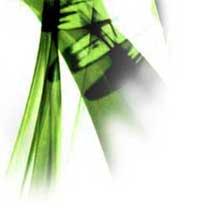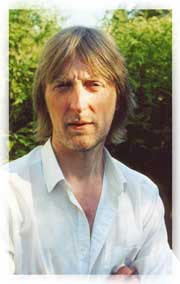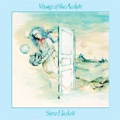



In October 2005 Ant released his sixth studio album – the sixth, that is, unless you also count all the records that were part of a series, a soundtrack, a compilation or simply not released under the Anthony Phillips label.
Private Parts & Pieces X: Soirée was published around the change of the millennium to present a cross-section of his contemporary piano works. It consisted almost exclusively of new recordings made between library and tv projects and plans were made for a similar release of new guitar music. The process of composing proved simple in 2001, but the technical realisation turned out to be quite difficult, as Ant candidly states in the sleeve notes. A long abstinence from the string instruments, old strings, bad posture, excessive rehearsal schedules and high demands on technical abilities in some pieces led to problems of the shoulder and the wrist. Several attempts to record the music in 2002 and 2003 failed because of copious bum notes. Just when he was about to give up, however, Ant managed to record most of the pieces in 2004. By that time he had grown weary of most of the compositions which was why he added a number of new pieces. Ant was assisted by the advice of old and young colleagues such as Jerry Gilbert and Jon Dann when, from a big heap or recordings, he selected a slightly smaller pile, i.e. no less than 61 pieces. Thus came about Ant’s first double album. Though the pieces were played only on the guitar and closely related instruments, they provide two hours, 8 minutes and 18 seconds’ worth of varied entertainment.
Ant’s positive assessment of the recording shows in that he gave it the rank of a “regular” album (originally it was announced as Private Parts & Pieces XI). He also titled it Field Day with all the positive connotations of a day off and the opportunity to spend it at one’s will.
Seventeen different instruments can be heard on the album. Some of them are only three or four years old and there are never two different instruments in one song. But these are by no means all instruments in Ant’s collection. He simply could not think of anything to play on the 8-string Rudloff guitar with which he recorded Magdalen (Sides) and Eduardo (Antiques); recordings of a charango piece were unsatisfactory. A number of pieces recorded on classical guitar (i.e. nylon strings) were struck off the list, leaving many metal string pieces on so that Ant could not find any space for a sitar piece (which will certainly surface in another collection in future times).
Most of the pieces are in D, E or G sharp or flat or other modes like Phrygian or Lydian. Ant used all the notes as a base, except for B. The rhythm usually is an even number, but rhythm patterns such like a 3+3+2 rhythm, a piece in 3, asymmetric and even freely changing rhythms occur.
The average song on the album is 2:06 long. Song lengths range from fifteen piece that are shorter than a minute (Driftwood is the shortest at 27 seconds) to seven pieces longer than 4 minutes; Concerto de Alvarez and To The Lighthouse extend beyond the 8 minute mark. The fact that there are many brief pieces here does not warrant the assumption that these are musical leftovers or even ideas that were not completely thought through. Quite a number of pieces belong to a larger context; for instance, they may segue into each other such as:
- Cerise > Runaway horses (total length: 3:50)
- Shimmering Sharon > Tea Room in Terra Del Fuego (1:41)
- Beyond the Castle Walls > Forgotten Pathway (3:24)
- Driftwood > Festoons and Billows > Flotsam and Jetsam > Sunfish Shallows (3:30)
- Eight pieces in D on the Parlour Guitar comprise the Parlour Suite (10:38). The introductory piece The Voyage Out (2002) re-emerges in four variations in the middle and at the end of either CD.
 The opening piece and its variations Chasing The Light, Half Way Out and
Out And Beyond (Tearaway does not count here) differ from the other
pieces in that some effects are used on them: Though it sounds like a
carpet of synthesizer sounds, it probably really is separated reverb
from a 12-string John Marlow guitar (note – that’s the correct
spelling). These tracks also fade in and out. Mix effects like these
hardly occur on the album; the only other exception is Girl In The
Gallery which has quiet backward guitar with reverb added).
The opening piece and its variations Chasing The Light, Half Way Out and
Out And Beyond (Tearaway does not count here) differ from the other
pieces in that some effects are used on them: Though it sounds like a
carpet of synthesizer sounds, it probably really is separated reverb
from a 12-string John Marlow guitar (note – that’s the correct
spelling). These tracks also fade in and out. Mix effects like these
hardly occur on the album; the only other exception is Girl In The
Gallery which has quiet backward guitar with reverb added).
While it is clear that there were at least two tracks mixed for these
pieces, non-professional listeners will have difficulties spotting use
of multiple tracks on other pieces. They may only marvel at how many
things can be played simultaneously on one instrument (e.g. White
Spider or To The Lighthouse). One also notices hardly any cuts (except
for, again, White Spider).
High Fives is a brief toccata in 5/8 that will reappear later for
Swoon. It opens the pentalogy of pieces played on the 6-string
L’Arrivée which is continued by the chorale Credo. The other pieces are
Cerise (played rubato), syncopated Runaway Horses and the finishing
sketch Home Sweet Home, which is not at all related to the song on
Peter Gabriel’s second album).
Steps Retraced could also be called Traces Restepped. It is an
instrumental version of the song Traces (Invisible Men) on the Fylde
Cittern recorded in 2001. In places, it follows the original closely,
but most of the time it is a paraphrase, a variation of the version Ant
wrote with Richard Scott in 1982. This is much more than just a cheap
cover.
The second piece with links to the past follows soon enough: Nocturne
was released in 1980 as No.6 of Ant’s Six Pieces For Guitar (Josef
Weinberger music publisher). Ant’s first recording of that piece was
released in September 1980 of the same year on Back To The Pavilion. In
2003 Quique Berro Garcia released quite a different interpretation of
the piece on his album Sueños that prompted Ant to attempt a rendition
better than 25 years ago. He considers his most recent attempt, in
which he, like Quique, simplifies the music, better than the original,
but still a long cry from perfect.
Nocturne is performed on a classical Ramirez guitar. This instrument
can also be heard on the title piece, which resembles pieces like
Bandido (Antiques), Girl In The Gallery and the triste Tryst.
Two varieties of the Cittern were used for this album. The Fylde
Cittern can be heard on Steps Retraced while the Bell Cittern by Paul
Hathaway is used for Bel Ami (a pun?). The cittern, incidentally, is
also called Lutherzither in German because the reformator Martin Luther
reputedly played this instrument that is closely related to the lute
and that is hardly played anymore today.
Shimmering Sharon and Tea Room In Terra Del Fuego resemble the
syncopated Bel Ami as far as sound and playing technique are concerned.
The booklet states that these two pieces were played on a charanga. A
charanga, however, is a Cuban style of dance music. What was really
meant was perhaps the charango, a ukulele-like Bolivian instrument, the
body of which is usually made of an armadillo’s back. “Tierra Del
Fuego” sports a spelling mistake, but there is no musical likeness to the
Finger Painting piece (the choice of instrument perhaps excepted?).
The only piece that was recorded on the 12-string Alvarez guitar is the
longest number on the album. It is an undisputed musical highlight. The
title, Concerto De Alvarez, may allude to the famous Concierto De
Aranjuez for guitar and orchestra by the Spanish composer Joaquín
Rodrigo, but never gets the music on this album closer to rock music
than on this piece. Not only does it remind of the energetic climaxes
of Trespass and Nursery Cryme, but is also proves that a putative reunion of
former members of Genesis for creative purposes would be incomplete
without Ant. A delicate theme gives structure to the Concerto,
appearing in the beginning, the middle, and at the end of the piece.
The parts in between are taken up mainly by non-stop sixteenth notes
that lead the music in (occasionally rough) harmonies and dynamics from
one climax to the next, not even omitting a fortissimo.
The classical Yari (Yairi?) guitar can be heard on five tracks. Lifer
is like a lied, its main theme resembles The Beatles’ Yesterday.
Equally delicious pieces are Days Of Grace, Oubliette (both in D flat
minor), Tania (in E flat major) and the intermezzo Timeline (in B flat
mixolydian).
The Parlour Suite is not as sophisticated as other elaborate suites
released on previous records, but that is not what it is here for. It
simply seemed like a good idea to combine these eight related and
similar pieces in a single suite in order to not having to name them
individually. The suite sounds contemplative like the evening bells.
One wonders what this Parlour guitar looks like because many an
unwanted little piece keeps resonating. Note the brilliant rhythm on
the almost yodeling part III.
The final piece on CD1 is the 12 string Marlow guitar we already know
from the opening number. River Of Life is (for fear of mistakes) faster
than Ant would play it for an evening’s meditation, but that does not
take away the slightest bit of the pleasure of listening to it. After
all, it is a beautiful study of the Doric scale in E. Momento is a
pleasant little sketch. Open Road took its title from the fact that it
is Ant’s first piece with an open tuning, i.e. the left hand (the one
on the fingerboard) does nothing at all while the other hand has to
place stress and produce a dynamic development. It works very well in
the 65 seconds of the piece.
White Spider is the third longest piece on Field Day. Its name comes
from the eponymous wall of rock of Mount Eiger in the Bern Alps in
which so many mountaineers have lost their lives. Lots of reverb make
for an eerie atmosphere resemblative of the Macbeth project (Scottish
Suites). White Spider certainly is a highlight on this release.
Weeping Willow is performed mainly in low notes. There is much musical
depth and places high demands on the performer’s skill: It is much
harder to play the ten-string guitar than, say, the 12-string. The
12-string is nothing but a normal 6-string with two strings per note
(one of which is usually tuned an octave up or down). On the 10-string
however, every string has its own individual note, which makes
orientation for both hands difficult – plus you have to have hands of
Rutherfordian dimensions. It is on this instrument, too, that Ant
mourns a Love Not Shared.
 Bouzoukis are a traditional instrument of Greek folklore that also
found their way into Irish music in 1965. Apparently there also is an
English version of this long-necked lute, and Ant plays it on four
numbers. Sojourn is followed by Dawn Over The Field Of Eternity. The
latter piece is not related to the Phillips/Rutherford composition).
While Ant was improvising Fallen City, the first news about the
terrorist attacks of September 11, 2001 were broadcast on the radio.
Ant heard about it because he always (!) has the radio on while he
improvises, but he was in denial about the shocking news… Rain on Sag
Harbor is a lovely onomatopoeic piece. Sag Harbor is a village in the
state of New York (hence the spelling without a “u”) that is mentioned
in Herman Melville’s Moby Dick. – A Greek Bouzouki can be heard on
Tearaway, one of the variations of The Voyage Out.
Bouzoukis are a traditional instrument of Greek folklore that also
found their way into Irish music in 1965. Apparently there also is an
English version of this long-necked lute, and Ant plays it on four
numbers. Sojourn is followed by Dawn Over The Field Of Eternity. The
latter piece is not related to the Phillips/Rutherford composition).
While Ant was improvising Fallen City, the first news about the
terrorist attacks of September 11, 2001 were broadcast on the radio.
Ant heard about it because he always (!) has the radio on while he
improvises, but he was in denial about the shocking news… Rain on Sag
Harbor is a lovely onomatopoeic piece. Sag Harbor is a village in the
state of New York (hence the spelling without a “u”) that is mentioned
in Herman Melville’s Moby Dick. – A Greek Bouzouki can be heard on
Tearaway, one of the variations of The Voyage Out.
More onomatopoiea in two other pieces: Babbling Brook also puns on the
fact that it was recorded on a 12-string Brook guitar. Mudlark is the
only piece that Ant recorded on a mandoline. It is not hard to imagine
such a bird.
The pieces that were recorded on the 6-string Brook guitar are truly
romantic. Midnight Blue (the only piece in F sharp), Evening Shroud,
Beyond The Castle Walls, Forgotten Pathway, Fairy Ring (complete with a
“broken record” effect at the end), Largo D’Amour and Kissing Gate have
appropriately suggestive titles. The intermezzos Rapscallion and a
jocose Whippersnapper liven things ups in between the other pieces.
And then there was another 12-string guitar Ant took from the rack: The
Guild guitar can be heard on To The Lighthouse. Once more the axiom
proves true that the longest pieces leave the deepest impressions –
this number is another highlight. At first it resembles the sixteenth
runs of Concerto De Alvarez before the distinctive sound of Private
Parts & Pieces V: Twelve takes over (around 2:04). From 3:23 on the
style is much that of the Gypsy Suite Ant recorded with Harry Williams.
A powerful reprise of the opening theme completes this piece.
The other four pieces performed on the Guild guitar are soundscapes
based mainly on one motive; they segue into each other. Driftwood is
the shortest number, Festoons And Billows sticks to much the same
harmonies. So do Flotsam And Jetsam (no link to Peter Gabriel II) and
Sunfish Shallows. Festoons has the right hand work just like for Open
Road.
Before the final Out And Beyond Ant takes out his ancient classical
Mirecourt guitar (we already heard it on Swoon) and dedicates two
compositions to one person each, Smart Alec and Prayer For Natalie.
Prayer… is the only piece from 2003). Ant usually titles his pieces
only when he has completed them. They often relate to a person, an
event (Fallen City) or something that is related to the song. Outsiders
will hardly note that unless Ant chooses to provide an explanation.
Natalie, for example, is a young lady friend who suffers from
Mucoviscidosis and has therefore unfortunately no high life expectancy.
The cover art originally was to be designed by Peter Cross. Ant
abandoned this idea and went for a more abstract, more “serious”
motive, as it were, that he found in an image databank. The CDs are
placed about a foggy sepia landscape photo Ant took himself.
What Ant has given us here is a delightful publication. It may not be a
compositional cornerstone like Twelve and it may not really be
broadening the scope. Still, never before have we had such a systematic
inventory of Ant’s string instruments. Never before have we had so many
musical ideas on a single “one man one instrument” album. We may be
relieved: Ant does not copy the pre-millennial Ant in this new
millennium. Given time and inspiration, he creates new things that
overflow with the joy of playing it. His playing technique is excellent
and so is the recording technology. Never before have we heard him
pluck the strings so clearly. We are treated to a wonderful massage for
the ears. No wonder that Intuitive Music listed this album among the 20
best releases of 2005 (incidentally, another album in this list was
John Hackett’s Checking Out Of London).
The album is worthwhile buying for Concerto De Alvarez alone. The
reviewer would caution the reader not to listen to the whole double CD
in one go. Take your time to listen to Anthony Phillips in one go, have
a Field Day to enjoy it!
by Andreas Lauer
photo by Helmut Janisch
translation by Martin Klinkhardt




Steves first Soloalbum from 1975, with Phil Collins and Mike Rutherford. Remaster Version from 2005 with Bonustracks.
Review available